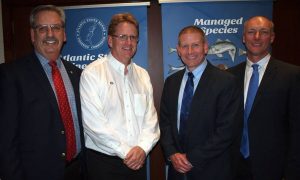July 31, 2020 — The following was released by NOAA Fisheries:
NOAA Fisheries was notified by the U.S. Coast Guard of a distressed humpback whale in the Ambrose Channel of New York on Monday, July 27. One of our New York stranding network partners, the Atlantic Marine Conservation Society (AMSEAS), immediately began working with the New York State Department of Environmental Conservation (NYSDEC) on plans to get a good look at the animal and confirm its location. AMSEAS reached out to the Center for Coastal Studies (CCS) in Provincetown, Massachusetts, our lead authorized disentanglement partner for the area, to discuss the situation.
On Monday evening, AMSEAS went out with NYSDEC staff on one of their vessels to the location provided by the USCG. They determined the whale was still alive and able to breathe. It appeared to be anchored in place but staff could not see any entangling material.
After reviewing the initial photos from Monday, AMSEAS and NYSDEC returned to the whale on Tuesday and were able to secure better images confirming the entanglement and its configuration, which were holding the whale’s tail down. After relaying this information back to CCS and NOAA and further assessing the urgent situation, we worked together to plan for a disentanglement attempt.
On Wednesday morning, USCG verified that the whale was still anchored in the same position. CCS disentanglement staff were flown from Massachusetts to New York on a flight donated by our partners at Turtles Fly Too. By Wednesday afternoon, the disentanglement team was able to remove multiple buoys and make cuts through pieces of entangling gear around the whale’s flukes. Despite their best efforts, the whale was still anchored in place, and the team had to leave the whale when it got too dark to continue safely.
Early Thursday morning, the NYSDEC vessels with the AMSEAS and CCS teams were back on the water. The research vessel Heidi Lynn Sculthorpe, from Monmouth University’s Urban Coast Institute, transported a team member from NOAA Northeast Fisheries Science Center’s (NEFSC) Sandy Hook lab to the whale. Working with the R/V Heidi Lynn Sculthorpe and the U.S. Army Corps of Engineers Drift Collection Vessel HAYWARD, crews used heavy equipment to secure and haul some of the heavy gear, which allowed the CCS team to make cuts that relieved pressure on the whale’s body. Around 4 p.m., final cuts were made releasing the whale from a very large and complicated entanglement.
This event demonstrated the need for a deliberate approach with patience and endurance, and the collaboration of local resources and expertise to support a skilled and experienced disentanglement team.
We are extremely grateful to all of our partners who were involved in what turned out to be one of the most complex whale entanglements we have encountered. Because of them, this whale was given a second chance at life.
Read the full story on our website, including quotes from our partners and a listing of all the organizations involved and their roles.

